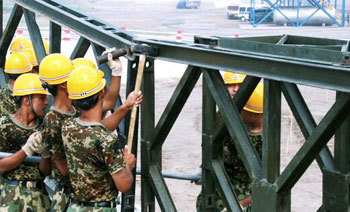How to prevent cracks in the Bailey bridge support? How to reinforce it?
2023-05-11
How to prevent cracks in the Bailey bridge support? First, strengthening the initial curing of the concrete is more important. After the concrete for the Bailey bridge support is poured, it should generally be covered promptly with straw mats, straw bags, or plastic film, and kept moist with water for curing. In high temperature, low humidity, and high wind speed conditions, the curing cover and spraying should be done as soon as possible, and the curing time should be appropriately extended. To avoid general temperature cracks caused by internal constraints in the concrete, it is generally recommended to control the temperature difference between the concrete and the external or internal environment to be less than 25 degrees. The usual control method is: for components that are heat-cured, a slow temperature rise and fall should be adopted, with the temperature change not exceeding 1 degree.
How to prevent cracks in Bailey panel supports?

First, strengthening the initial curing of concrete is more important. After the concrete for the Bailey panel support is poured, it should generally be covered with grass mats, grass bags, or plastic film cages in a timely manner, and watered for moist curing. In high temperature, low humidity, and high wind speed weather, the curing cage cover and spraying should be done as soon as possible, and the curing time should be appropriately delayed. To avoid general temperature cracks caused by internal constraints in the concrete, the temperature difference between the concrete and the external or internal environment should generally be controlled to be less than 25. The usual control method is: for components that are heat-cured, a slow temperature rise and fall should be adopted, with a temperature change not exceeding 10/h, and the cover should be slowly removed to avoid excessive general temperature stress; for large volume structures, when the temperature difference between the concrete and the external environment exceeds at night, insulation curing should be adopted, and the temperature difference during formwork removal should be controlled within 25.
To avoid general temperature cracks caused by internal constraints in the concrete, the temperature difference between the concrete and the external or internal environment should generally be controlled to be less than 25. The usual control method is: for components that are heat-cured, a slow temperature rise and fall should be adopted, with a temperature change not exceeding 10/h, and the cover should be slowly removed to avoid excessive general temperature stress; for volume arrangements, when the temperature difference between the concrete and the external environment is large, insulation curing should be adopted, and the temperature difference during formwork removal should be controlled within 25.
Reasonably set construction joints, pour water stops at appropriate locations, and accelerate heat dissipation; when pouring large volume concrete on rock foundations or thicker concrete pads, a sliding layer should be laid on the pad (pouring asphalt mastic, laying sand, or laying roll materials), and a cushioning layer should be laid on vertical surfaces (sticking polyethylene foam) to eliminate the impact of embedding and release bonding stress. Choose well-graded coarse aggregates and strictly control their mud content; strengthen concrete vibration to improve concrete density and tensile strength; set the required temperature reinforcement in the foundation; at joints, appropriately increase the reinforcement ratio, set hidden beams, reduce edge effects, and improve tensile strength; at the same time, strengthen the initial curing of concrete to improve initial tensile strength and elastic modulus.
The reinforcement method for Bailey panel supports is to achieve correction, reinforcement, increased bearing capacity, and enhanced functionality through the reinforcement construction process. Therefore, the choice of reinforcement scheme should be based on improving the quality of the reinforcement project. There are also non-standard construction preparations and quality assessment standards for non-standard reinforcement schemes.
I. Preparation before reinforcement
When using prestressed reinforcement methods with prestressed rods, the rods need to be straightened in advance before installation, and the size and position of the rods need to be accurate. Before tensioning, check the quality of welded joints, screws, and nuts, and check the embedded depth of the welded seams between the Bailey bridge support angle steel (and its base plate) and the concrete components.
II. Filling and Reinforcement
After passing inspection, fix both ends of the support with bolts, and then fill with epoxy mortar or high-strength cement mortar. The reinforced support limbs, connection plates, slats, and tensioning bolts should be coated with anti-rust paint for corrosion protection. During the reinforcement construction of the Bailey panel support, the focus should be on the comprehensive treatment of the contact surface of the concrete and the bonding surface of the steel plate. For dry rebar construction, ensure that the angle steel closely adheres to the profile of the component.
III. Concrete Precautions
The concrete needs to be ground smooth, free of debris and dust; when using wet rebar construction, a rough coat of latex cement slurry or epoxy resin chemical grouting material should be applied to the treated angle steel and concrete, the steel plate should be derusted, the concrete should be dusted, and the steel plate and concrete should be cleaned with acetone or xylene before bonding and pouring.
Béret, Béret panel, Béret panel support

